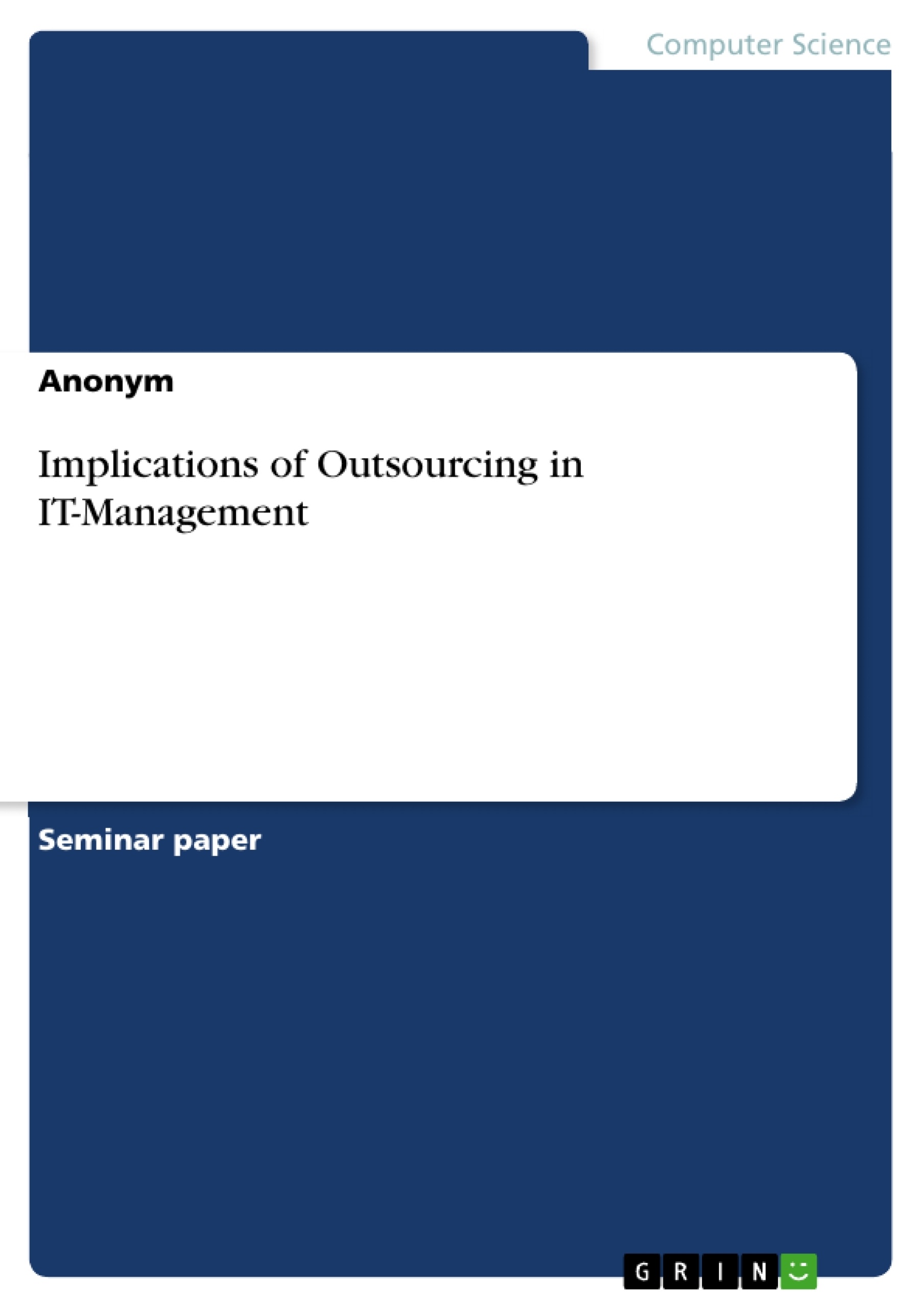This paper takes a closer look at aspects surrounding the importance and application of IT outsourcing and aims to provide a sound understanding of the term as well as the forms of outsourcing strategy in today’s IT-based or IT-driven industries. Since outsourcing is a subject that is not necessarily only associated with advantages, a closer look at the disadvantages of outsourcing will also be taken in the course of this paper.
Outsourcing has become increasingly popular as a technique to reduce costs and to access a wider range of technical expertise (in-house competencies versus outsourcing noncore competencies). Especially concerning the second example, outsourcing has become a standard method of project and labour management if a firm decides to migrate to a newer technology. In the IT industry, companies may outsource system development, system operations, help desk, systems, databases, and application administration, as well as a desktop and network support. Furthermore, businesses may use outsourcing to obtain application service provision or business process outsourcing.
Considering an IT activity a commodity, there is little benefit to doing it internally. Payroll processing, for instance, is often considered a commodity IT activity. In these cases, focused vendors are likely capable of providing the service at a higher level of quality and/or at a lower cost. By taking advantage of economies of scale that other organizations have, a business that specializes in the same field can become more cost-effective. With respect to the given advantages, outsourcing of IT resources and services is proving to be an increasing trend on the global market. Companies such as cloud providers specializing in many manifestations of IT outsourcing (Infrastructure as a Service (IaaS), Platform as a Service (PaaS), Software as a Service (SaaS)) show a growing turnover, which is expected to increase further in the forecast beyond 2021.
Inhaltsverzeichnis (Table of Contents)
- 1 Introduction
- 1.1 Actuality and Importance of Outsourcing
- 1.2 Structure and Approach
- 2 Fundamentals of Outsourcing
- 2.1 Definition
- 2.2 Historical Development of the Idea of Outsourcing and its Concept
- 2.3 Forms of Integration and Possibilities in Outsourcing
- 2.4 IT services and their Possibility for Outsourcing
- 2.5 Phases of Outsourcing
- 3 Motivation and Risks of IT-Outsourcing
- 3.1 Chances of Outsourcing
- 3.1.1 Strategic Chances
- 3.1.2 Financial Chances
- 3.1.3 Other Definable Opportunities
- 3.2 Risks of Outsourcing
- 3.2.1 Strategic Risks
- 3.2.2 Financial Risks
- 3.2.3 Other Definable Risks
- 4 Conclusion
Zielsetzung und Themenschwerpunkte (Objectives and Key Themes)
This term paper aims to explore the implications of outsourcing in IT management. It examines the historical development, different forms of integration, and the motivation behind outsourcing. The paper also addresses potential risks and challenges associated with this practice.
- Definition and historical development of outsourcing
- Forms of integration and possibilities in outsourcing
- Motivation for IT outsourcing, including strategic and financial benefits
- Risks and challenges associated with IT outsourcing
- Phases of the outsourcing lifecycle
Zusammenfassung der Kapitel (Chapter Summaries)
- Chapter 1: Introduction This chapter introduces the topic of outsourcing in IT management, highlighting its relevance and significance in today's business environment. It also outlines the structure and approach of the paper.
- Chapter 2: Fundamentals of Outsourcing This chapter provides a comprehensive overview of outsourcing, including its definition, historical development, forms of integration, and its application to IT services. It further explores the different phases involved in the outsourcing process.
- Chapter 3: Motivation and Risks of IT-Outsourcing This chapter examines the various motivations behind IT outsourcing, focusing on both strategic and financial benefits. It also explores the potential risks associated with this practice, including strategic, financial, and other definable risks.
Schlüsselwörter (Keywords)
This paper focuses on key concepts such as outsourcing, IT management, strategic and financial benefits, risks and challenges, historical development, forms of integration, and IT services. It explores the complexities of this practice and provides a comprehensive understanding of its implications in today's business landscape.
- Quote paper
- Anonym (Author), 2021, Implications of Outsourcing in IT-Management, Munich, GRIN Verlag, https://www.hausarbeiten.de/document/1152718


